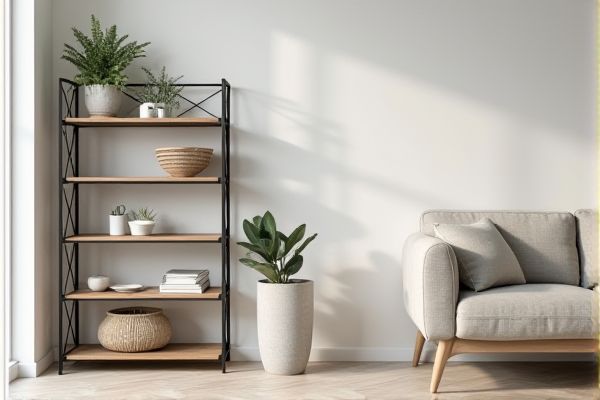
Wire shelves offer superior ventilation and moisture resistance, making them ideal for humid environments or pantry storage, while wood shelves provide a warmer aesthetic and sturdy surface suitable for heavier items or decorative purposes. Discover which shelf type best suits Your needs by exploring the detailed comparisons in the rest of this article.
Table of Comparison
| Feature | Wire Shelf | Wood Shelf |
|---|---|---|
| Material | Metal wires, typically steel with coating | Solid wood or engineered wood |
| Durability | Rust-resistant if coated, sturdy, resists warping | Can warp or crack with moisture, generally sturdy |
| Weight Capacity | High load capacity, ideal for heavy items | Moderate to high, depends on wood type and thickness |
| Ventilation | Excellent ventilation, prevents dust & moisture buildup | Poor ventilation, can trap dust and moisture |
| Maintenance | Easy to clean, wipe with damp cloth | Requires regular dusting and occasional polishing |
| Appearance | Industrial, minimalistic look | Warm, classic aesthetic |
| Cost | Generally affordable | Varies; often more expensive depending on wood quality |
| Best Use | Storage in garages, kitchens, and warehouses | Home decor, living rooms, and display purposes |
Introduction: Wire Shelf vs Wood Shelf
Wire shelves offer superior ventilation and moisture resistance, making them ideal for kitchens, pantries, and laundry rooms where airflow prevents mold and rust. Wood shelves provide a warmer aesthetic and greater load-bearing capacity, suitable for living spaces or display units requiring sturdy support and a decorative touch. Choosing between wire and wood shelves depends on environmental conditions, weight requirements, and desired style.
Material Composition and Durability
Wire shelves are typically made from steel or stainless steel coated with epoxy or chrome, offering superior resistance to moisture, rust, and corrosion, making them highly durable in humid environments. Wood shelves consist of solid wood or engineered wood, providing strong load-bearing capacity but are more prone to warping, cracking, or damage from prolonged exposure to moisture. Choosing between wire and wood shelves depends on your need for durability and environmental conditions where the shelves will be installed.
Aesthetic Appeal and Design Choices
Wire shelves offer a modern, industrial aesthetic with an open design that enhances visibility and airflow, making them ideal for minimalist and contemporary spaces. Wood shelves provide a warm, classic look with a variety of finishes that can complement traditional, rustic, or elegant interiors. Your choice depends on whether you prefer sleek, airy storage or rich, textured design elements.
Load-Bearing Capacity and Strength
Wire shelves offer superior load-bearing capacity due to their metal construction and open design, which evenly distributes weight and prevents sagging under heavy loads. Wood shelves provide strong support but may weaken over time with exposure to moisture or heavy use, making them less reliable for consistently heavy items. For industrial or high-weight storage, wire shelves are preferred for their durability and resistance to deformation.
Installation Process and Flexibility
Wire shelves offer straightforward installation with lightweight, adjustable components that can be easily mounted using brackets or clips, making them highly flexible for changing storage needs. Wood shelves typically require more precise measurements, securing with screws or anchors, and may involve tools like drills or levels, resulting in a more permanent setup. Your choice depends on whether you value the quick adaptability of wire shelving or the sturdy, fixed nature of wood shelves.
Maintenance and Cleaning Requirements
Wire shelves are easier to clean due to their open design, allowing dust and debris to fall through and preventing buildup. Wood shelves require more maintenance, including regular dusting, polishing, and occasional refinishing to prevent damage from moisture and stains. Your choice depends on how much time you're willing to invest in upkeep and the environment where the shelf will be placed.
Cost Comparison: Wire vs Wood
Wire shelves generally cost less than wood shelves due to cheaper materials and simpler construction processes. Wood shelves often involve higher expenses for quality lumber, finishing, and labor-intensive craftsmanship. Choosing wire shelves can save you money upfront while maintaining durability, especially for utilitarian storage needs.
Best Applications for Wire Shelves
Wire shelves excel in environments requiring ventilation and moisture control, such as kitchens, pantries, and laundry rooms. Their open design prevents dust accumulation and allows air circulation, making them ideal for storing food, cleaning supplies, and damp items. The durability and adjustable nature of wire shelving also make it suitable for commercial use in warehouses and retail displays.
Best Applications for Wood Shelves
Wood shelves excel in applications requiring a warm, aesthetic appeal and sturdy support, making them ideal for living rooms, bedrooms, and offices where style complements function. Their solid construction supports heavy items like books, decor, and kitchenware while offering customization through staining and carving. You will find wood shelves particularly beneficial in spaces prioritizing elegance and durability over ventilation or minimalistic design.
Choosing the Right Shelf for Your Needs
Wire shelves offer excellent ventilation and moisture resistance, making them ideal for kitchens, bathrooms, and laundry rooms, while wood shelves provide a sturdy, aesthetic appeal suited for living spaces and offices. Consider the weight capacity, exposure to humidity, and overall decor of your room when deciding between durability and style. Your choice should align with both functional requirements and visual harmony to enhance the organization and design of your space.
 homyna.com
homyna.com